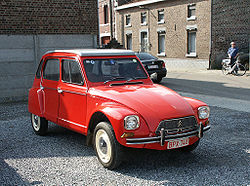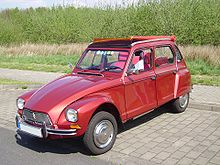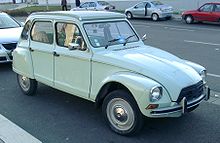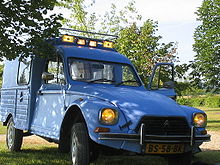- Citroën Dyane
-
Citroën Dyane 
Manufacturer Citroën Production 1967—1983 Assembly Rennes, France Predecessor None Successor Citroën Visa
Citroën AxelClass Supermini Body style 5-door hatchback Layout FF layout Engine 435 cc Flat-2
602 cc Flat-2Wheelbase 94.5 in (2,400 mm)[1] Length 153.5 in (3,899 mm)[1] Width 59 in (1,499 mm)[1] Curb weight 1,310 lb (594 kg)[1] (approx) Related Citroën 2CV
Citroën Ami
Citroën Méhari
Citroën FAF
Citroën BijouThe Citroën Dyane is an economy car/supermini produced by the French automaker Citroën from 1967 to 1983. Based on the Citroën 2CV, 1,444,583 examples were manufactured. A panel van version called the Acadiane derived from the Dyane.
Contents
Market context
The Dyane was a development of the Citroën 2CV, and was intended as an answer to the increasingly popular Renault 4, which after its introduction in 1961 had affected 2CV sales. The Renault 4 incorporated many ideas copied from the Citroën Traction Avant, but on a smaller scale. Like the Renault 4, the Dyane was designed from the outset as a hatchback with some other styling differences, such as conventional round headlamps set into the front fender with a squared chrome trim ring – as opposed to the old-fashioned separate units found on the 2CV – and stainless steel wheel embellishments as standard. It is often believed that the Dyane was intended to replace the 2CV, but it was aimed slightly higher in the Citroën range – between the 2CV and the Ami – and attracted a different clientele seeking the versatility offered by the Dyane's hatchback.[citation needed] From the mid 1950s until the 1970 Citroën GS, Citroën had no car in the mid size market segment and needed to make the most of the Citroën 2CV chassis.
Panhard connections
At the time of the Dyane's development, the Citroën design department was busy on updates of the key DS and Ami models: design of the Dyane was therefore initially subcontracted to the Panhard design department, Panhard's non-military business having in 1965 been absorbed into Citroën's car business. The Panhard team under Louis Bioner produced a proposal that proved controversial with management: the car was significantly reworked ahead of launch. The Dyane's Panhard associations are also reflected in its name, Panhard having registered a copyright on the name Dyane along with Dyna, Dynavia and Dynamic.
Engine and running gear
As with the 2CV, the engine was air-cooled, with a hemispherical combustion chamber and flat-topped pistons. Initially only the same 425cc engine was offered. Later versions gained a choice between the new 435 and 602cc engines: the 602 featured higher compression pistons and forced induction from the engine fan giving slightly more power than the Citroën 2CV. Cooling air was ducted straight to the heater, giving excellent demisting and heating. Mechanical contact-breakers were mounted to the crankshaft and seated behind the cooling fan. The Fan was mounted on a tapered shaft and secured with a bolt at the bottom of a deep tube (the top of which engaged the starter handle), so that a common problem was that the points were not adjusted and the bolt was rounded off when people tried. The Coil fired both cylinders simultaneously (wasting one spark) and the spark plug wear was faster than it ought to have been; 6000 miles was not uncommon for a spark plug.
Cylinder heads were held on with three studs and barrels slipped over the pistons. No Cylinder-head gasket was used, and since the wings unbolted in a few minutes, it was possible to remove the cylinder heads and barrels, change the pistons or piston-rings and reassemble the top end within an hour and using only a few tools.
It was based on the same platform chassis as the Citroën 2CV, sharing its advanced independent front to rear interconnected suspension. This comprised a central springing unit, running fore-and-aft in a tube on each side; each wheel hub on that side was linked by levers to the shock-absorber, which had a long travel. See Citroën 2CV for detailed information. The squeak you hear from most 2CVs and Dyanes as they go by is the lack of lubrication; they need some lithium-based grease to be applied using a knife every few thousand miles. Similarly, the front hubs have kingpins; these need to be greased every few thousand miles. Since they are usually not greased, the king-pins wear and an expensive repair is needed at MoT (involving welding new king-pin journals in, although a plastic-injection kit used to be available to reduce play).
The Dyane was also available with the "trafficlutch" - a centrifugal clutch which helped avoid stalling whilst in slow moving urban traffic.
UK press reaction
In the UK, a Citroën Dyane 6 tested by the British "The Motor" magazine in July 1969 had a top speed of 68.6 mph (110.4 km/h) and could accelerate from 0-60 mph (97 km/h) in 30.8 seconds. An overall fuel consumption of 36.0 miles per imperial gallon (7.85 L/100 km; 30.0 mpg-US) was recorded, although when driven gently the Dyane managed a class leading 51.0 miles per imperial gallon (5.54 L/100 km; 42.5 mpg-US). The test car was priced by Citroen in the UK at £648 including taxes, the same price that BMC were sticking on their Mini 1000 Super. The car was commended for its versatility, spaciousness and comfort as well as for unexpectedly good road holding and fuel economy ‘when not driven hard’. Acceleration and top speed fell short of the class average, however. Apart from the Mini, UK market competitors identified by the journal included the Hillman Imp and the Reliant Rebel as well as the (at the time very popular ) Renault 4[2]
Iranian manufacture
The Dyane was also built in Iran from 1968 to 1980, where it was called the Jyane - a Persian word meaning "fierce" or "ferocious". Unique van and pick-up versions were also manufactured there.
References
External links
- Deux Chevaux Club of Great Britain
- Citroën World: Dyane/Acadiane links
- P CITROËN DYANE
- Dyane modelcars
- 2CV (&Dyane) district CitCity
- Dyane at Citroenet
- A Car - A Song with the Dyane
Type 1950s 1960s 1970s 0 1 2 3 4 5 6 7 8 9 0 1 2 3 4 5 6 7 8 9 0 1 2 3 4 5 6 7 8 9 Economy car 2CV Off-roader Méhari Supermini LN / LNA Dyane Ami Visa Small family car GS Large family car 11 CV ID / DSpécial / DSuper Executive car 15 CV DS CX Grand tourer SM « previous — Automobiles Citroën, a subsidiary of the PSA Peugeot Citroën since 1976, car timeline, 1980s–present Type 1980s 1990s 2000s 2010s 0 1 2 3 4 5 6 7 8 9 0 1 2 3 4 5 6 7 8 9 0 1 2 3 4 5 6 7 8 9 0 1 Economy car 2CV Off-roader Méhari City car C1 Supermini LN / LNA AX Dyane Axel Saxo I Saxo II C2 DS3 Visa C3 I C3 II Small family car GSA ZX Xsara I Xsara II C4 I C4 II DS4 Large family car BX Xantia C5 I C5 II DS5 Executive car CX XM C6 Leisure
activity vehicleAcadiane C15 Nemo Berlingo Berlingo II Compact
MPVXsara Picasso C3 Picasso C4 Picasso Large MPV Evasion/Synergie C8 C4 Grand Picasso Crossover C-Crosser Convertible C3 Pluriel Van H Van C25 Jumpy I Jumpy II C35 Jumper Jumper II Citroën PSA Peugeot Citroën · Category · Vehicles
Current - Europe Current - China (DPCA) Historic Trucks Concept cars G Van · Prototype C · Prototype Y · 2CV Pop · GS Camargue · C44 · Karin · Zabrus · Activa · C6 Lignage · C-SportLounge · C-Airplay · C-Buggy · C-Airdream · GT by Citroën · Hypnos · DS Inside · Revolte · Survolt · C-CactusMotorsport Electric vehicle Categories:- Citroën 2CV
- Citroën vehicles
- Subcompact cars
- Vehicles with boxer engines
- 1960s automobiles
- 1970s automobiles
- 1980s automobiles
Wikimedia Foundation. 2010.









